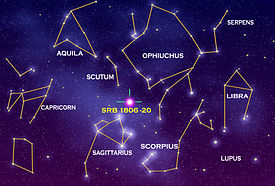This is an old revision of this page, as edited by 75.6.224.251 (talk) at 03:16, 27 December 2011 (→Explosion). The present address (URL) is a permanent link to this revision, which may differ significantly from the current revision.
Revision as of 03:16, 27 December 2011 by 75.6.224.251 (talk) (→Explosion)(diff) ← Previous revision | Latest revision (diff) | Newer revision → (diff) This is where SGR 1806-20 would appear in the sky if it were visible to human eyes. | |
| Observation data Epoch J2000 Equinox J2000 | |
|---|---|
| Constellation | Sagittarius |
| Right ascension | 18h 08m 39.32s |
| Declination | −20° 24' 39.5"' |
| Apparent magnitude (V) | totally obscured |
| Distance | 50,000 light-years (14.5 kiloparsecs) |
| Other designations | |
| GRB 790107, INTEGRAL1 84, AX 1805.7-2025 GRB 970912, INTREF 882, CXOU J180839.3-202439, HETE Trigger 1566, KONUS 07.01.79, EQ 1805.7-2025, HETE Trigger 3801, PSR J1808-2024, GBS 1806-20, HETE Trigger 3800, RX J1808.6-2024. | |
SGR 1806-20 is a magnetar, a particular type of neutron star. It has been identified as a soft gamma repeater. SGR 1806-20 is located about 14.5 kiloparsecs (50,000 light-years) from Earth on the far side of our Milky Way galaxy in the constellation of Sagittarius. It has a diameter of no more than 20 kilometres (12 mi) and rotates on its axis every 7.5 seconds (30,000 km/h rotation speed at the surface). As of 2007, SGR 1806-20 is the most magnetized object ever perceived by humankind, with a magnetic field over 10 gauss (10 teslas) in intensity (compared to the Sun's 1–5 gauss). SGR 1806-20 has a magnetic field that is a quadrillion (short scale) times stronger than that of the Earth.
Explosion
On December 27, 2004, the radiation from an explosion on the surface of SGR 1806-20 reached Earth. In terms of gamma rays, the burst had an absolute magnitude around −29. It was the brightest event known to have been sighted on this planet from an origin outside our solar system. The gamma rays struck the ionosphere and created more ionization, which briefly expanded the ionosphere. The magnetar released more energy in one-tenth of a second (1.3×10 J) than our sun has released in 100,000 years (4×10 W × 3.2×10 s = 1.3×10 J). Such a burst is thought to be the largest explosion observed by humans in the galaxy since the SN 1604 supernova observed by Johannes Kepler in 1604.
A similar blast within 3 parsecs (10 light years) of Earth would destroy the ozone layer and would be similar to a 12 kt of TNT (50 TJ) nuclear blast at 7.5 km. The nearest known magnetar to earth is 1E 1048.1-5937, located 9,000 light-years away in the constellation Carina.
Location
SGR 1806-20 lies at the core of radio nebula G10.0-0.3 and is a component of cluster 1806-20, itself a component of W31, one of the largest H II regions in the Milky Way. Cluster 1806-20 is made up of some highly unusual stars, including at least two carbon-rich Wolf–Rayet stars (WC9d and WCL), two blue hypergiants, and LBV 1806-20, one of the brightest/most massive stars in the galaxy.
See also
- Cl* 1806-20 –- star cluster
- LBV 1806-20 –- luminous blue variable
- Soft gamma repeater
- Bryan Gaensler
Notes
- ^1 As measured by various space-based and land-based astronomical observatories, including the Swift spacecraft.
References
- Cosmic Explosion Among the Brightest in Recorded History NASA date 02.18.05.
- "Top story – Scientists measure the most powerful magnet known". Retrieved 14 December 2007.
External links
- An exceptionally bright flare from SGR 1806-20 and the origins of short-duration big gamma-ray bursts, 2005-04-28 (Nature)
- Huge 'star-quake' rocks Milky Way, 2005-02-18, (BBC News Online)
- Brightest galactic flash ever detected hits Earth 2005-02-18 (space.com)
- 2005-02-20 (The Age) Registration required.
- Huge quake cracks star 2005-09-27 (space.com)
- NASA Sees Hidden Structure Of Neutron Star In Starquake (SpaceDaily) April 26, 2006